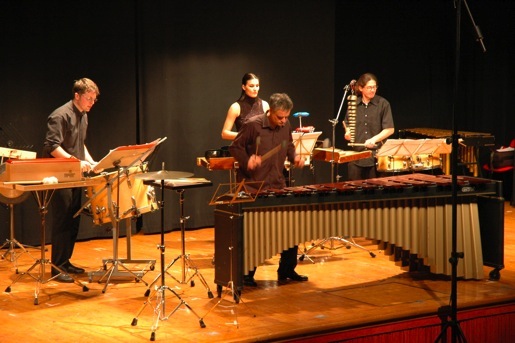Minoru Miki Marimba Spiritual
In late 1983 Minoru MIKI received the request from Ms. Keiko Abe to compose new marimba piece with three percussionists. She had a chance to perform new piece with Dutch percussionists in next year.
Miki composed “Time for Marimba” in 1968 and “Concerto for Marimba and Orchestra” in 1969. However in 1964 he founded “Pro Musica Nipponia”, a historically initial ensemble consisting of all sort of Japanese traditional instruments. Over the next twenty years he worked hard to compose many different types of pieces for them and to produce them not only in Japan but all over the world. He sought to realize new possibilities for this musical style. Also in 1975 he began to compose opera series along Japanese long history since 5th Century to 19th Century.
So he did not resume composing for the marimba until 1983.
During that year he decided to retire from Pro Musica Nipponia to concentrate on the creation of operas, as he felt that he had completed his present aim in expanding the repertoire for traditional Japanese instruments.
When Miki completed the vocal score of the 1st Act of his third opera “Joruri”, Ms. Abe just asked him to compose a new marimba piece with three percussionists. For him, it was rare opportunity to compose his third marimba piece. He started thinking about the piece on Christmas day in 1983, and completed it on January 13th, 1984. A NHK producer agreed to commission the piece at Ms. Abe’s request.
This was also the year that many people died in Africa from starvation. As a person who had experienced similar suffering before and after the end of World War II, Miki could not be silent. Rather he felt that he must express his condolences and anger for that situation. He therefore composed the first slow section as a static requiem, and the second fast section as lively resurrection. The title “Marimba Spiritual” is as expression of the total process.
Many performers and listeners have been curious about the mode of the first section, wondering whether or not the composer was consciously combining a number of different scales. Although Miki has welcomed such interpretation and analysis, he insists he had no specific model in mind when composing the piece, but rather that he gave his imagination free reign over the harmonic and melodic material.
The rhythm and note patterns are strictly noted throughout the piece, but as for the three percussion parts, only the relative pitches and tone qualities (for the first part, metal and wood percussion instruments; for the second part, skin drums) are noted. There is some freedom, but the performers should pay much attention to balance between each section. The rhythmic patterns for the second part are taken from the festival drumming of the Chichibu area northwest of Tokyo.
The total duration is approximately 14 minutes.
The world premiere was given on March 18, 1984 at the Concertgebouw in Amsterdam with Ms. Abe and the Nieuwe Slagwerk Groep Amsterdam. After the premiere, Ms. Abe premiered the piece in many countries in Europe and America, each time with different percussion ensembles. After its publication by Ongaku No Tomo Sha, Tokyo in 1989 (NORSK MUSIKFORLAG A/S for Europe and America), countless groups performed the piece probably several thousand times. In 1988, the Safri Duo played the piece with only two people. The recording was so excellent that Miki gave them permission to arrange the piece and named the result “Marimba Spiritual 2” (see www.amazingmusicworld.com). The Safri Duo performed the piece more than 700 times all over the world throughout the 1990’s. Both the original piece and “Marimba Spiritual 2” have frequently appeared in many different venues, from TV CM to numerous contemporary music festivals.



Live Performance: may 2005
Massimo Pastore : marimba
Art Percussion Ensemble: Vanni Vespani, Silvia De Checchi, Daniele Scambia: percussion
